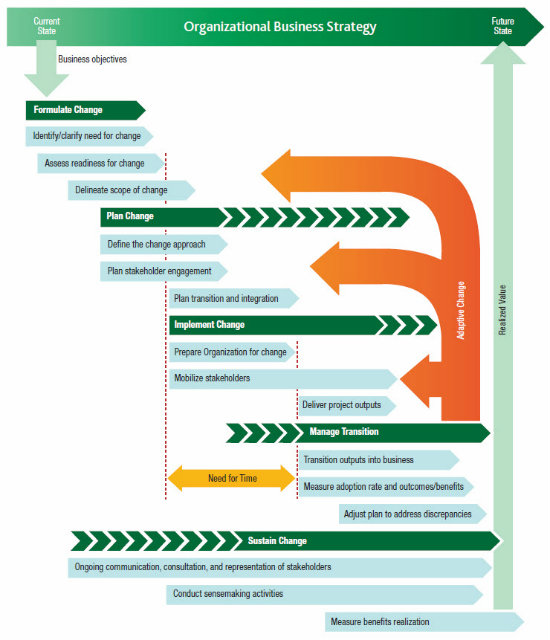In my post Creating Value from Change I looked at the difference between project change control and organisational change management:
- Project change control is described in the PMBOK® Guide and focused on managing changes to the projects deliverables to meet the requirements of stakeholders. The process is controlled by the project manager, although authority to approve changes usually sits at a higher level of management or with the customer.
- Organisational change is the interaction with the wider stakeholder community to prepare them to make the best use of the new ‘product, service or result’, being created by the work of the project. The project manager and project team members are important agents in this change, but rarely have the authority to directly manage the people in the operational part of the organisation of the customer’s organisation.
Organisations that take change seriously have efficient processes in place to train staff, reconfigure work practices, and provide front line help or support to ensure the project’s deliverables are effectively used to create value. Many are now also tracking the realisation of benefits once the project’s work is finished and the new product has been transitioned to operations (or to the client) – closing the loop back to the promised benefits in the ‘business case’.
Some of the key elements needed for organisational change to be successful include:
- Creating clarity for all of the affected stakeholders;
- Clear and simple governance;
- Taking the time to get the environment right so the change team can operate effectively;
- Understanding the scope and nature of the change;
- Work within the existing culture to change the culture;
- Engage and communicate continuously.
Whilst there is always a degree of risk associated with any change initiative, the type of change described above to introduce an upgraded software system or market a new product, is fairly well understood and there are books, guidelines and role descriptions for change managers and benefits managers, and organisations that fail to use these recognised ‘good practices’ are in effect choosing to increase the risk of failing to achieve the planned ‘return on investment’. However, there is an emerging body of evidence that this type of ‘business as usual’ change (typically associated with a project and a single ‘goal’) is very different from changes designed to transform an organisation (typically associated with a program and a range of ‘goals’).
There is confusion between what constitutes conventional change versus transformational change. We have a good idea of how to manage conventional change; most organisations continue to struggle with transformation.
Conventional change management means implementing finite initiatives, which may or may not cut across the organisation. The focus is on executing a well-defined shift in the way things work to achieve one or more defined benefits. It’s not easy, but we know what to do to maximise the chance of success by applying well-known change management principles and tools, such as explaining the reason for the change, building a coalition of leaders, getting early results, engaging stakeholders, executing with discipline, etc. Use the tools effectively and there is a good chance the transition will go smoothly and the expected benefits realised.
Organisational transformation is altogether different! The overall objective of transformation is not just to execute a defined change, rather to reinvent the organisation, change culture and behaviours and discover (rather then create) a new way of working based on a vision for the future – this creates a paradigm shift in the degree of complexity involved in implementing the change successfully.
|
. Transformational change . |
Conventional Change |
| Works holistically | Focuses on specific parts of the organisation |
| Focuses on strategy | Focuses on ‘problem-solving’ |
| Step change | Incremental change |
| Involves all stakeholders | Centres on process owners |
Unlike conventional change management, transformation management cannot simply focus on a few discrete, well-defined shifts, but rather on a coordinated portfolio of interdependent initiatives and the emergent outcomes.
Delivering the capabilities for this type of initiative is the realm of program management; multiple projects building the different elements needed for the overall transition. Multiple projects, requiring multiple change initiatives, which together lead the organisation on a journey of discovery towards it new ‘future state’. Even when successful change management leads to the successful implementation of certain initiatives within the transformation portfolio, the overall transformation could still fail.
This type of transformation is far more unpredictable, iterative, and experimental than traditional project or program management, and consequently entails much higher risk. The key elements needed to build success are firstly a clear vision of the final outcome, strong and sustained leadership, supported by good stakeholder engagement; with the flexibility to adapt the program of work based on feedback from earlier initiatives. The ultimate vision may not change, but the route to success will need continuous adaptation to overcome obstacles and exploit opportunities.

©2014 Project Management Institute, Inc.
PMI’s 2015 white paper, The Model for Sustainable Change, focuses on this type of transformational initiative (but is useful reading for any change initiative). Its ‘SUSTAIN’ model lays a strong framework for success:
- Support from the top
- Utilize change-sustaining approaches
- Shift paradigms when needed
- Talk and communicate
- Assimilate and integrate
- Invest in planning for sustained results
- Negotiate results with a portfolio approach
The journey to successful change starts with recognising the type of change you are involved in and then adapting your approach to meet the needs of the situation, and particularly with ‘transformational change’ allowing enough time in the overall implementation for the change to take root and grow – this period should be measured in terms of months and years.
Everyone is talking about the need for change, change in the culture of bank’s ‘wealth management’ divisions, change in the competitive environment due to various trade agreements, the need to deal with the consequences of climate change, etc. So given change is inevitable, how does your organization approach its change management initiatives?



Pingback: Everyone is talking about change | blueskychange
Pingback: Managing Change | Easy information
This is an interesting article that explains the complexity of change. It is not easy to implement new ideas. The process needs to be approached with care in order to generate the desired results.